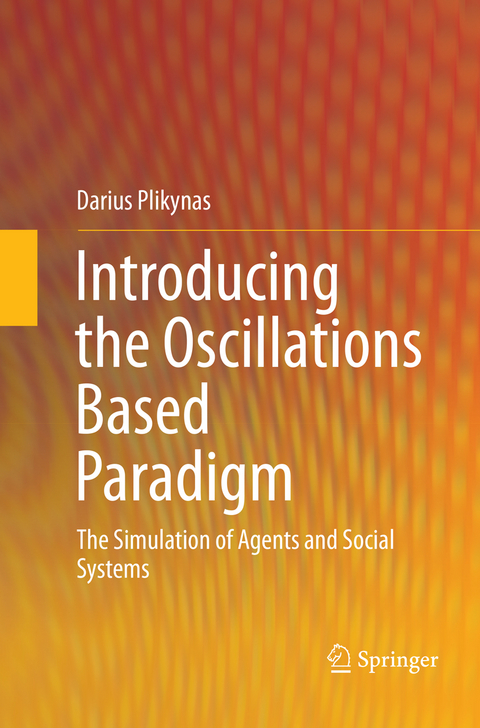
Introducing the Oscillations Based Paradigm
Springer International Publishing (Verlag)
978-3-319-81801-6 (ISBN)
The book presents a conceptually novel oscillations based paradigm, the Oscillation-Based Multi-Agent System (OSIMAS), aimed at the modelling of agents and their systems as coherent, stylized, neurodynamic processes. This paradigm links emerging research domains via coherent neurodynamic oscillation based representations of the individual human mind and society (as a coherent collective mind) states. Thus, this multidisciplinary paradigm delivers an empirical and simulation research framework that provides a new way of modelling the complex dynamics of individual and collective mind states.
This book addresses a conceptual problem - the lack of a multidisciplinary, connecting paradigm, which could link fragmented research in the fields of neuroscience, artificial intelligence (AI), multi-agent system (MAS) and the social network domains. The need for a common multidisciplinary research framework essentially arises because these fields share a common object of investigation and simulation, i.e., individual and collective human behavior. Although the fields of research mentioned above all approach this from different perspectives, their common object of investigation unites them. By putting the various pathways of research as they are interrelated into perspective, this book provides a philosophical underpinning, experimental background and modelling tools that the author anticipates will reveal new frontiers in multidisciplinary research.
Fundamental investigation of the implicit oscillatory nature of agents' mind states and social mediums in general can reveal some new ways of understanding the periodic and nonperiodic fluctuations taking place in real life. For example, via agent states-related diffusion properties, we could investigate complex economic phenomena like the spread of stock market crashes, currency crises, speculative oscillations (bubbles and crashes), social unrest, recessionary effects, sovereign defaults, etc. All these effects are closely associated with social fragility, which follows and is affected by cycles such as production, political, business and financial. Thus, the multidisciplinary OSIMAS paradigm can yield new knowledge and research perspectives, allowing for a better understanding of social agents and their social organization principles.
Foreword by Andrea Omicini.- Foreword by John T. Cacioppo.- Preface.- Chapter 1 Synopsis.- Chapter 2 Towards Wavelike Approach.- Chapter 3 Oscillation-based social simulation paradigm: The Conceptual Premises.- Chapter 4 From Baseline Individual to Social Neurodynamics: Experimental Framework.- Chapter 5 OAM-Based Simulation of Human Brain EEG Signal Dynamics using coupled Oscillators Energy Exchange Model (COEEM).- Chapter 6 Mind-Field States and Transitions: Quantum Approach.- Chapter 7 OAM Construction Based on the Universal Free Energy Term: Conceptual Scope and Simulation Results.- Chapter 8 OAM-Based MAS: Simulation Setup and Results.- Chapter 9 Agent-Based Modeling of Excitable Social Media Fluctuations.- Chapter 10 Agent-Based Modeling of Fluctuations in Automated Trading Systems.- Appendix A Autopoietic Systems.- Appendix B Global Workspace Theory.- Appendix C Embodied and Distributed Cognition.- Appendix D Cognition, Categorization, and Adaptive Resonance.- Appendix E Basic Mind States and Quantum Holography.
"For enthusiastic readers, the book offers novel methodological approaches to study the physical nature of social cognition and behavior. ... This pioneering book consists of 11 chapters ... presented in a chronological way. ... Throughout the book, there are ... many high-quality and illustrative pictures, diagrams, and tables. An extensive list of references is provided at the end of the book, which gives readers many opportunities for additional reading. The physical and technical quality of the book is very good." (Computing Reviews, September, 2017)
| Erscheinungsdatum | 05.03.2022 |
|---|---|
| Zusatzinfo | XXIV, 325 p. 97 illus., 16 illus. in color. |
| Verlagsort | Cham |
| Sprache | englisch |
| Maße | 155 x 235 mm |
| Gewicht | 5329 g |
| Themenwelt | Informatik ► Theorie / Studium ► Künstliche Intelligenz / Robotik |
| Mathematik / Informatik ► Mathematik ► Finanz- / Wirtschaftsmathematik | |
| Wirtschaft ► Betriebswirtschaft / Management | |
| Schlagworte | Agent-Based Systems • cognitive science • Complex Systems • Computer Science • Multi-agent Systems • Oscillating Systems • Oscillation-Based Multi-Agent System (OSIMAS) • Pervasive Information Field • social agents • Social neuroscience • Sociodynamics |
| ISBN-10 | 3-319-81801-5 / 3319818015 |
| ISBN-13 | 978-3-319-81801-6 / 9783319818016 |
| Zustand | Neuware |
| Informationen gemäß Produktsicherheitsverordnung (GPSR) | |
| Haben Sie eine Frage zum Produkt? |
aus dem Bereich


